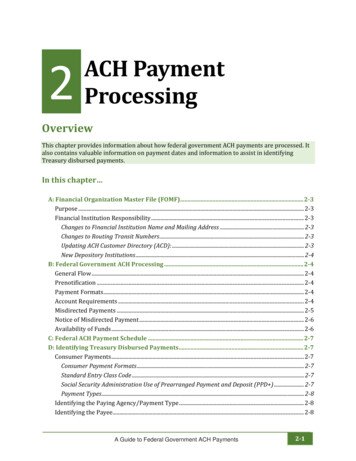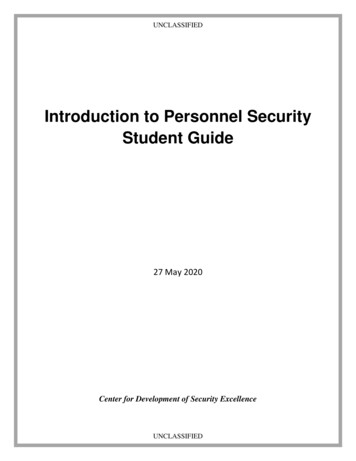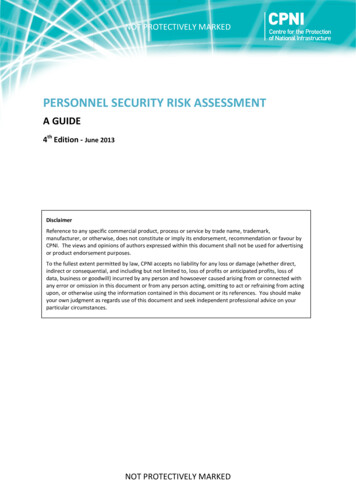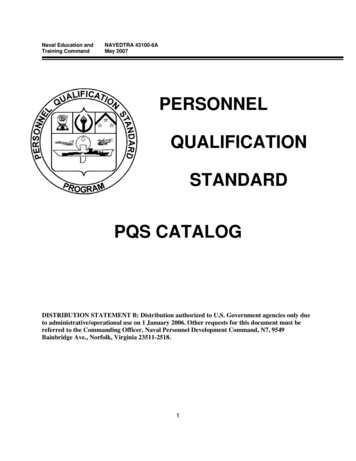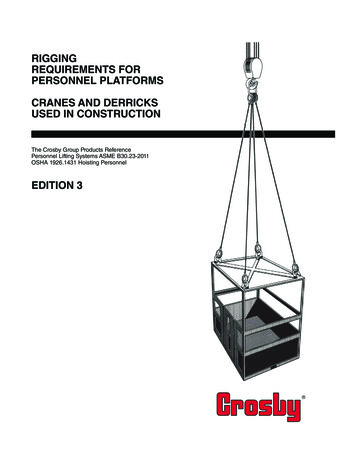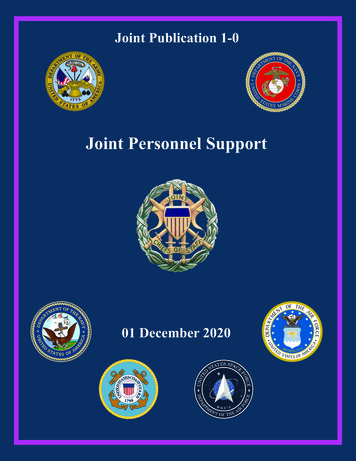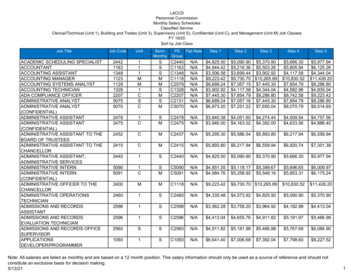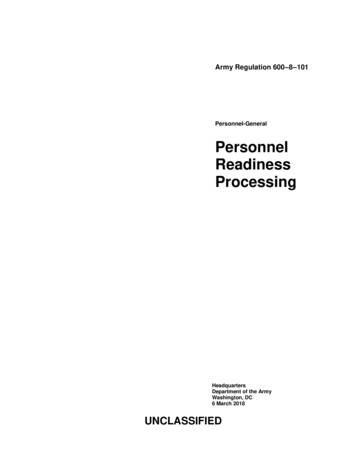
Transcription
Army Regulation ocessingHeadquartersDepartment of the ArmyWashington, DC6 March 2018UNCLASSIFIED
SUMMARY of CHANGEAR 600–8–101Personnel Readiness ProcessingThis major revision, dated 6 March 2018—oChanges the name of the regulation from Personnel Processing (In-, Out-, Soldier Readiness, and Deployment Cycle)to Personnel Readiness Processing (cover).oEliminates “Deployment Cycle Support” and all references (throughout).oReplaces “ARFORGEN” with “Sustainable Readiness” in accordance with Army Directive 2016–07 (throughout).oIncorporates “readiness” after personnel to be consistent with Army Directive 2016–07 and the terminology of“personnel readiness” (throughout).oIncorporates administrative deployability standards (Adjustments to Administrative Policy) from Army Directive2016–07, Enclosure 3 (Personnel Readiness Transformation) (throughout).oEliminates DA Form 7631 (Deployment Cycle Support (DCS) Checklist) and all references (throughout).
HeadquartersDepartment of the ArmyWashington, DC6 March 2018*Army Regulation600–8–101Effective 6 April 2018Personnel-GeneralPersonnel Readiness ProcessingHistory. This publication is a major revision.Summary. This regulation prescribespolicy, standards, and requirements for performing the functions of in-processing, outprocessing, the Soldier Readiness Programand mobilization processing, and deployment processing. The process institutes internal controls for out-processing, the Soldier Readiness Program, and deploymentprocessing; and prescribes the use of DAForm 5123 (In- and Out-Processing Records Checklist), DA Form 5123–1 (In- Processing Personnel Record), DA Form137–1 (Unit Clearance Record), DA Form137–2 (Installation Clearance Record), andDA Form 7425 (Readiness and Deployment must include formal review by the activity’s senior legal officer. All waiver reChecklist).quests will be endorsed by the commanderApplicability. This regulation applies toor senior leader of the requesting activitythe Regular Army, the Army Nationaland forwarded through their higher headGuard/Army National Guard of the Unitedquarters to the policy proponent. Refer toStates, and the U.S. Army Reserve, unlessAR 25–30 for specific guidance.otherwise stated. Also, it applies to ReserveComponent Soldiers ordered to full-time Army internal control process. Thisduty in the Active Guard Reserve Program regulation contains internal control proviper AR 135–18; active duty under partial, sions and provides an Internal Controlfull, or total mobilization; active duty for a Evaluation for use in evaluating key interPresidential Reserve call up and active duty nal controls (see appendix B).to fill active duty vacancies per ARSupplementation. Supplementation of135–210. Under partial, full, or total mobithis regulation and the establishment oflization and under contingency plan condicommand local forms are prohibited by thetions, only the policy proponent may modDeputy Chief of Staff, G–1 (DAPE–MP),ify provisions of this regulation.300 Army Pentagon, Washington, DCProponent and exception authority. 20310–0300.The proponent of this regulation is the DepSuggested improvements. Users areuty Chief of Staff, G–1. The proponent hasinvited to send comments and suggestedthe authority to approve exceptions orimprovements on DA Form 2028 (Recomwaivers to this regulation that are consistentmended Changes to Publications and Blankwith controlling law and regulations. TheForms) directly to the Deputy Chief ofproponent may delegate this approval auStaff, G–1 (DAPE–MP), 300 Army Pentathority, in writing, to a division chief withingon, Washington, DC 20310–0300.the proponent agency or its direct reportingunit or field operating agency, in the grade Distribution. This publication is availaof colonel or the civilian equivalent. Activ- ble in electronic media only and is intendedities may request a waiver to this regulation for the Regular Army, the Army Nationalby providing justification that includes a Guard/Army National Guard of the Unitedfull analysis of the expected benefits and States, and the U.S. Army Reserve.Contents (Listed by paragraph and page number)Chapter 1Introduction, page 1Purpose 1–1, page 1References 1–2, page 1Explanation of abbreviations and terms 1–3, page 1Responsibilities 1–4, page 1The Personnel Readiness Processing Program 1–5, page 2Program standards 1–6, page 3The readiness activity structure 1–7, page 4Program policy 1–8, page 4Rules for operating installation welcome activities 1–9, page 5Internal controls 1–10, page 5Adjustments to Administration Policy 1–11, page 5*This regulation supersedes AR 600-8-101, dated 19 February 2015.AR 600–8–101 6 March 2018UNCLASSIFIEDi
Contents—ContinuedChapter 2In-Processing, page 6The in-processing record 2–1, page 6Installation-level or community-level in-processing 2–2, page 6Battalion or unit in-processing requirements 2–3, page 7Chapter 3Out-Processing, page 7DA Form 137–1, DA Form 137–2, and DA Form 5123 3–1, page 7Out-processing requirements 3–2, page 8Internal control process for out-processing 3–3, page 9Battalion or unit out-processing requirements 3–4, page 9Installation-level or community-level out-processing 3–5, page 10Chapter 4Soldier Readiness Program and Mobilization Processing, page 12Soldier Readiness Program requirements 4–1, page 12Internal control process for the Solider readiness processing 4–2, page 13Mobilization requirements 4–3, page 13Expansion of the readiness activity for mobilization 4–4, page 13Battalion and unit Soldier readiness processing and mobilization processing requirements 4–5, page 14Installation-level and/or community-level Soldier readiness processing and mobilization processing 4–6, page 14Chapter 5Deployment Processing, page 15Deployment readiness requirements 5–1, page 15Internal control process for deployment processing 5–2, page 16Deploying unit readiness validation process 5–3, page 16Unit, brigade, or battalion deployment processing requirements 5–4, page 16Installation-level and/or community-level deployment readiness 5–5, page 16AppendixesA. References, page 18B. Internal Control Evaluation, page 25GlossaryiiAR 600–8–101 6 March 2018
Chapter 1Introduction1 –1. PurposeThis regulation prescribes the military personnel readiness processing requirements for in-processing; out-processing forpermanent change of station (PCS), transition, extended temporary duty (TDY) (90 or more days), individual temporarychange of station (TCS), and unit deployments (including overseas deployment training); the Soldier Readiness Program(SRP) and mobilization; deployment processing, unit readiness validation, and deployment processing requirements; andredeployment processing requirements and post deployment activities (reverse SRP, demobilization, and personal reconstitution processing). Procedures for these personnel readiness processing requirements are contained in DA Pam600–8–101.1 –2. ReferencesSee appendix A.1 –3. Explanation of abbreviations and termsSee glossary. Also, the term “Soldiers” means commissioned officers in the rank of colonel and below and all warrantofficers and enlisted personnel.1 –4. Responsibilitiesa. The Assistant Secretary of the Army (Manpower and Reserve Affairs) will oversee personnel readiness processingpolicies. Such policies will support the sustainable readiness (SR) process in order to provide trained and ready forces tothe combatant commanders, when those forces are needed.b. The Deputy Chief of Staff, G–1 (DAPE–MP) will—(1) Establish personnel policies relating to the readiness processing of Regular Army (RA) and Reserve Component(RC) Soldiers.(2) Ensure the Commanding General, U.S. Army Human Resources Command (HRC) will—(a) Exercise responsibility for all U.S. Army Reserve (USAR) Active Guard Reserve (AGR) Soldiers.(b) Implement applicable policies in this regulation and develop mobilization orders and instructions that direct USARAGR Soldiers, Individual Ready Reserve (IRR) Soldiers, individual mobilization augmentees, and recalled retirees orderedto active duty in support of a Presidential Reserve call-up (PRC) or higher level of mobilization to bring the requireddocuments for in-processing at a designated reception station or like activity.(c) Ensure that DA Form 7425 and all applicable documents or automated information containing DA Form 7425 areforwarded for all USAR Soldiers ordered to active duty in support of a PRC or any level of mobilization.(d) Develop procedures and maintain programs to implement standards and operating tasks for the personnel program.(e) Develop procedures to support transfer of required data from the USAR and Army National Guard (ARNG) tomobilization stations or supporting personnel information system processing activities to support arriving USAR units,National Guard units, IRR Soldiers, AGR Soldiers, individual mobilization augmentees, and recalled retirees ordered toactive duty in support of PRC, or any level of mobilization.(f) Ensure the Commandant, Adjutant General School establishes lesson programs of instruction incorporating the provisions of this regulation.c. The Chief, Army Reserve will—(1) Recommend RC mobilization policy and operational tasks to the Deputy Chief of Staff, G–1 regarding the processing of RC Soldiers and Families.(2) Establish, resource, and operate a readiness processing program that accomplishes the requirements established bythis regulation.d. The Chief, National Guard Bureau will—(1) Recommend RC mobilization policy and operational tasks to the Deputy Chief of Staff, G–1 regarding the processing of RC Soldiers and Families.(2) Exercise the same responsibilities as the Commanding General, HRC for all ARNG AGR Soldiers.(3) Implement applicable policies in this regulation for all ARNG AGR Soldiers and ensure that they are processed fordeployment under this regulation as necessary in support of contingency operations during PRC or any level of mobilization.AR 600–8–101 6 March 20181
e. Commanders, Army commands, Army service component commands, and direct reporting units will monitor andassist in the administration of the readiness processing program to ensure compliance with the policies and operating tasksestablished by this regulation.f. Commanders of each installation, unit, community, and mobilization station will establish, resource, and operate areadiness processing program that accomplishes the requirements established by this regulation. Unit commanders willensure that all personnel under their command and control (that is, Soldiers, other Department of Defense (DOD) militarypersonnel, civilian employees, and contractors) continually maintain the highest state of personal readiness and completeall SRP requirements to support unit mission requirements in a timely manner. Unit commanders will also ensure compliance with the SR requirements process.1 –5. The Personnel Readiness Processing Programa. The Personnel Readiness Processing Program prepares, certifies, and reports individual Soldier and unit readinessfor deployment, including shortfalls, to the unit commander and consists of—(1) In-processing at Army installations and communities, which—(a) Extends from installation and/or community to brigade adjutant general, battalion, or unit.(b) Welcomes and acclimatizes the individual Soldier and Family on board.(c) Welcomes and acclimatizes the individual Soldier back on board upon return from a deployment (that is, reintegration, whether from an individual TCS or a unit deployment). Some installations call reintegration (or the processing ofreturning Soldiers) back into the home station a reverse SRP.(d) Ensures that in-processing Soldiers meet assignment eligibility and that all nondeployable conditions are identified.If any nondeployable conditions are identified, corrective action must be taken or appointments made any the deficiencieswill be reported to the gaining unit commanders on the deployability status of reintegrating Soldiers. Level 1 SRP will becompleted for all in-processing Soldiers.(2) Out-processing at Army installations and communities, which—(a) Extends from brigade, battalion, and unit to installation community level.(b) Ensures the proper processing of Soldiers, including those absent or unavailable, from one duty station to anotheror transition from active duty status to another status (for example, release from active duty of RC Soldiers, separation, ordischarge from active duty of RA Soldiers due to expiration of term of service or administrative reasons (that is, chapteractions, medical separation, or retirement).(c) Provides an orderly process resulting in preparation and validation reporting of individual Soldier readiness statusto the losing and gaining commanders.(d) Executes the senior commander’s responsibility to ensure that the Soldier meets assignment eligibility criteria priorto departing on PCS. Deploying Soldiers and Soldiers on assignment to a deploying unit will not be cleared for departureif conditions precluding deployment exist or the medical status is unknown (for example, the Soldier's medical status isunknown due to an out of date Physical Health Assessment).(e) Ensures the proper processing of Soldiers, including those absent or unavailable, from active duty to a differentstatus (for example, separated, discharged, released from active duty, retired, and demobilized).(f) Identifies and collects payment for debts owed to the Government and the central clearance participating agencies.May collect and assist in the collection of debts owed to the Government and its instrumentalities, such as nonappropriatedfund activities and the Post Exchange. Notifies commanders regarding debts owed to private or commercial organizationsthat are central clearance participating agencies per the procedures of paragraphs 3–5a(7) and 3–5a(8).(g) Identifies Soldiers who require a determination of precedence of disability evaluation to other separation, releasefrom active duty, or retirement action.(3) SRP, which—(a) Is a set of personnel qualification standards approved by Headquarters, Department of the Army (HQDA) policyproponents.(b) Provides for the continual administrative readiness of Soldiers for deployment.(c) Determines a Soldier’s readiness status for worldwide deployment.(d) Is checked, certified, and reported during in-processing and out-processing and continually monitored at unit levelfor RA Soldiers.(e) Is checked, certified, and reported annually for ARNGUS Soldiers in units and USAR Soldiers in troop programunits and for all RC Soldiers when called to active duty (for example, mobilization, overseas deployment training, or activeduty for operational support).(f) Properly processes and ensures the deployability of all Soldiers departing their home station for transit to a deployment station.(4) Mobilization processing, which—2AR 600–8–101 6 March 2018
(a) Includes home station and mobilization station processing requirements to administratively add individuals andunits to the active force.(b) Involves expansion of the peacetime in-processing and-out-processing activity as a sub-work unit of the installationmobilization and deployment activity.(c) Involves installation task force operations, if a partial or higher state of mobilization has been declared.(d) Specifies the readiness requirements for all RC Soldiers when called to active duty for mobilization.(5) Extended TDY processing, which—(a) Properly processes Soldiers for departure on an extended TDY of 90 or more days.(b) Is an abbreviated version of the out-processing program designed to ensure that Soldiers departing on a TDY tripprojected to last 90 or more days are qualified for the duty, that readiness standards are maintained, and that they receivethe appropriate level of personnel service support.(6) Deployment processing of individual Soldiers and units, which—(a) Involves only actual individual TCS or unit deployments during contingency operations or training missions.(b) Requires that specific SRP requirements be met prior to actual movement.(c) Is administered by both the home stations and installations that have been designated as mobilization or deploymentstations. If Soldiers, either as individuals or as members of units, deploy directly from the home station to the theater orTCS station, the home station is also their mobilization or deployment station.(d) Executes the senior commander’s responsibility to ensure that only Soldiers who meet readiness standards are deployed.(7) Redeployment processing of individual Soldiers and units, which—(a) Ensures the proper processing of Soldiers who are departing the theater or TCS station to return to the home stationor, in cases of extreme need, to redeploy to another theater or TCS station.(b) Ensures that, in cases of extreme need, only Soldiers who still meet the readiness and deployability requirementsare redeployed to the next theater or TCS station.(c) Identifies debts owed to the Government and central clearance participating agencies in the theater or at the TCSstation. Collects and assists in the collection of debts owed to the Government and its instrumentalities, such as nonappropriated fund activities and the Post Exchange. Notifies commanders regarding debts owed to private or commercial organizations that are central clearance participating agencies.b. The personnel readiness processing program may be supplemented by brigade, battalion, unit, installation, or community-based operational procedures to meet local requirements. However, supplementation of this regulation and establishment of command and local forms are prohibited without prior approval from the Deputy Chief of Staff, G–1(DAPE–MP).c. The activities through which all Soldiers must process are indicated on the processing forms. Commanders mayrequire Soldiers to process through additional activities listed on the forms and/or some local activities not listed (uniquelocal activities can be added).d. The supervisor of each readiness processing activity will ensure that all Soldiers are completely processed beforegranting clearance.1 –6. Program standardsa. In-, out-, Soldier readiness, mobilization, and deployment processing is a multifunctional program that supports theSR process and—(1) Establishes both peacetime and wartime military personnel processing standards.(2) Is resourced in base operations.(3) Under centralized conditions, Soldier readiness, mobilization, and deployment processing facilities operate undergeneral management of the garrison directorate of plans, training, mobilization, and security. In-processing and out-processing facilities operate under general management of the garrison military personnel division (MPD).b. Execution of the in-, out-, Soldier readiness, mobilization, and deployment processing multifunctional program. Thisprogram requires connectivity with the following functions and multifunctional programs:(1) Enlisted personnel management.(2) Enlisted promotions and reductions.(3) Enlisted transfers or discharges.(4) Suspension of favorable personnel actions.(5) Identification documents.(6) Leaves and passes.(7) Officer personnel management.(8) Officer promotions.AR 600–8–101 6 March 20183
(9) Officer transfers or discharges.(10) Personnel accounting and strength reporting.(11) Personnel security clearances.(12) Reassignments.(13) Retention.(14) Sponsorship.(15) Transition processing.(16) Battalion personnel service support.(17) Orders program.(18) Personnel record.(19) Exceptional Family Member Program.(20) Soldier for Life-Transition Assistance.(21) Personnel tempo.(22) Medical screening.(23) Dental screening.(24) Deployment Health Assessment Program.(25) Education center.(26) Behavioral health (including Substance Abuse).(27) Family Advocacy Program.c. The military personnel and finance functional proponents will support the program
This regulation prescribes the military personnel readiness processing requirements for in-processing; out-processing for permanent change of station (PCS), transition, extended tem
